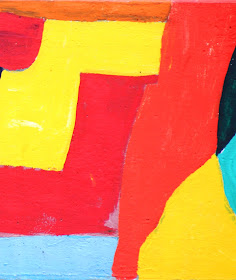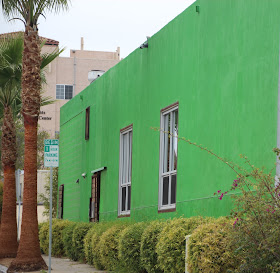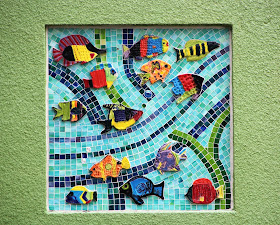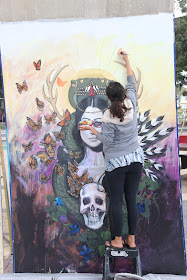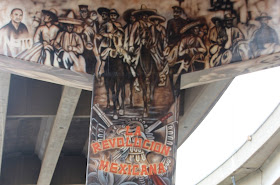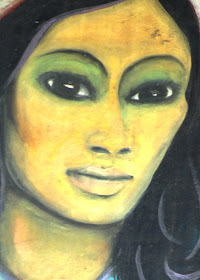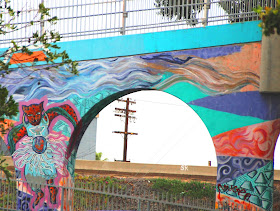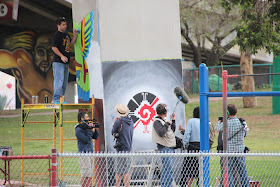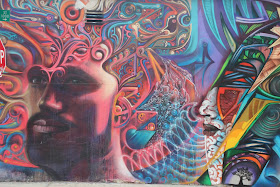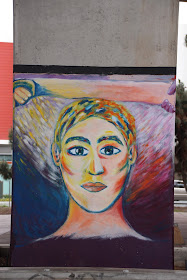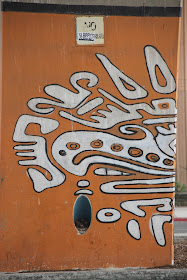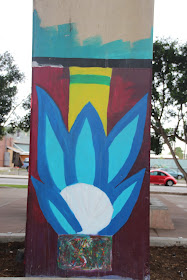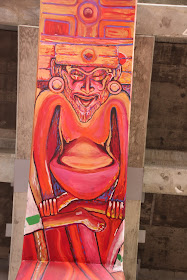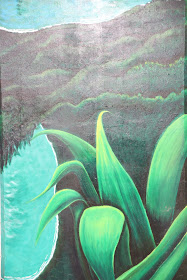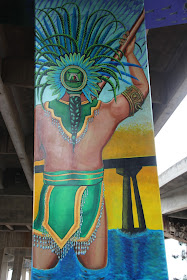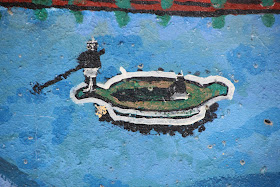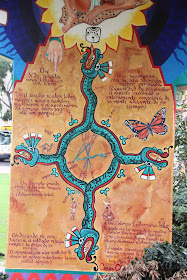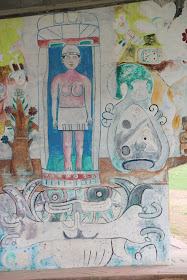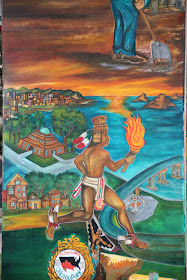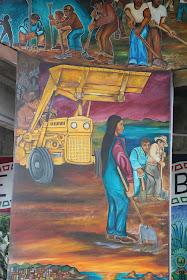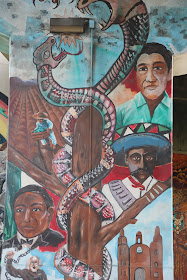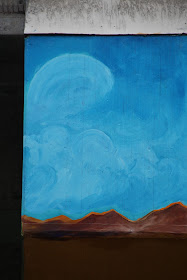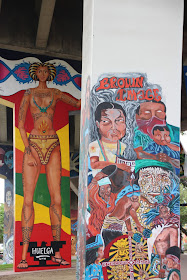Why do
two colors, put one next to the other, sing? Can one really explain this? no.
Just as one can never learn how to paint. Pablo
Picasso
Man has been endowed with reason,
Man has been endowed with reason, with the power to create, so that he can add to what he's been given. -- Anton Chekhov (1860-1904) Russian Dramatist and Writer
The Logan Park Artists
Chicano Park is a 32,000 square
meter (7.9 acre) park located beneath the San Diego-Coronado Bridge in Barrio
Logan, a predominantly Mexican American and Mexican-immigrant community in
central San Diego, California.
The park is home to the country's largest
collection of outdoor murals as well as various sculptures, earthworks, and an
architectural piece dedicated to the cultural heritage of the community. For
the magnitude and historical significance of the murals, the park was
designated an official historic site by the San Diego Historical Site Board in
1980, and its murals were officially recognized as public art by the San Diego
Public Advisory Board in 1987.
The park was listed on the National Register
of Historic Places listings in San Diego County, California in January 2013
owing to its association with the Chicano civil rights movement. Chicano Park,
like Berkeley's People's Park, was the result of a militant (but nonviolent)
people's land takeover. Every year on April 22 (or the nearest Saturday), the
community celebrates the anniversary of the park's takeover with a celebration
called Chicano Park Day.
The area was originally known
as the East End, but was renamed Logan Heights in 1905. The first Mexican
settlers there arrived in the 1890s, followed soon after by refugees fleeing
the violence of the Mexican Revolution, which began in 1910. So many Mexican
immigrants and Mexican-Americans settled there that the southern portion of
Logan Heights eventually became known as Barrio Logan.
The original neighborhood
reached all the way to San Diego Bay, with waterfront access for the residents.
This access was denied beginning with World War II, when Naval installations
blocked local access to the beach. The denial of beachfront access was the
initial source of the community's resentment of the government and its
agencies.
This resentment grew in the
1950s, when the area was rezoned as mixed residential and industrial. Junk
dealers and repair shops moved into the barrio, creating air pollution, loud
noise, and aesthetic conditions unsuitable for a residential area. Resentment
continued to grow as the barrio was cleaved in two by Interstate 5 in 1963 and
was further divided in 1969 by the elevated onramps of the San Diego-Coronado
Bridge.
At this time, Mexicans were
accustomed to not being included in discussions concerning their communities
and to not being represented by their officials, so no formal complaint was
lodged.
This attitude began to change
in the turbulent decade that brought the demands of African Americans, women,
and other oppressed peoples for equality and full inclusion in American
society.
As the various campaigns
coalesced under the banner of the Chicano Movement (for the right to organize
and collectively bargain, led by César Chávez and Dolores Huerta of the United
Farm Workers, the rights to the full benefits guaranteed to veterans, led by
Dr. Hector P. Garcia of the American G.I. Forum, the right to equal and
pertinent education, led by the student group MEChA which issued the Plan de
Santa Barbara, for the rights of Mexicans guaranteed under the Treaty of Guadalupe
Hidalgo, (especially land grants and bilingual education) under Reies Tijerina,
and for recognition of the historic contributions of Mexican-Americans and the
validity of Mexican culture) so too did the political awareness and sense of
empowerment grow in Barrio Logan.
Community residents had long
been demanding a park. The City Council had promised to build a park to
compensate for the loss of over 5,000 homes and businesses removed for the
construction of the freeway and bridge, as well as for the aesthetic
degradation created by the overhead freeways supported by a forest of gray
concrete piers. In June 1969, the park was officially approved and a site was
designated, but no action was taken to implement the decision.
The final straw came on April
22, 1970. On his way to school, a community member, San Diego City College
student, and Brown Beret member named Mario Solis noticed bulldozers next to
the area designated for the park. When he inquired about the nature of the work
being undertaken, he was shocked to discover that, rather than a park, the crew
was preparing to build a parking lot next to a building that would be converted
into a California Highway Patrol station.
Solis went door-to-door to
spread the news of the construction. At school, he alerted the students of
Professor Gil Robledo's Chicano studies class, who printed fliers to bring more
attention to the affair. At noon that day, Mexican-American high school
students walked out of their classes to join other neighbors who had already
congregated at the site.
Some protesters formed human
chains around the bulldozers, while others planted trees, flowers, and cactus.
Solis is reported to have commandeered a bulldozer to flatten the land for
planting. Also, notably, the flag of Aztlán was raised on an old telephone
pole, marking a symbolic 'reclamation' of land that was once Mexico by people
of Mexican descent.
When the crowd grew to 250,
construction was called off. The occupation of Chicano Park lasted for twelve
days while community members and city officials held meetings to negotiate the
creation of a park. During that time, groups of people came from Los Angeles
and Santa Barbara to join the occupation and express solidarity.
Not trusting the city and fearing that
abandoning the land would be tantamount to conceding defeat, an agreement was
finally reached whereby the recently formed Chicano Park Steering Committee
would call for an end to the occupation of the land while stationing informal
picketers on the public sidewalks around the disputed terrain to provide
residents with information regarding the project. They maintained that the park
would be re-occupied if negotiations failed.
At a meeting on April 23, a
young artist named Salvador Torres, recently returned to the barrio from the
College of Arts and Crafts in Oakland, shared his vision of adorning the
freeway support pillars with beautiful artworks. For this reason, he is
sometimes referred to as "the architect of the dream". Finally, on
July 1, 1970, $21,814.96 was allocated for the development of a 1.8 acre (7,300
m²) parcel of land.
While the creation of the park
was actually begun on the day of the takeover, with minor landscaping improvements
being undertaken by the occupiers, the murals that brought the park to
prominence were not begun until 1973.
With few exceptions, the
artists and their organizations raised the money necessary to purchase muriatic
acid to wash the columns, rubber surface conditioner to prepare them, and
paints.
Artists were invited from all
over the state, with notable contributions from the Royal Chicano Air Force of
Sacramento and the mural team of Charles "Gato" Félix, responsible
for the murals at the Estrada Courts in Los Angeles. Many non-Chicanos also
participated. Over time, more vegetation was planted to create a cactus garden.
Other additions to the park
have been piecemeal, as the comprehensive "Master Plan" put forth by
the artists was never adopted by the city. The park has expanded, and currently
reaches almost "all the way to the bay", a phrase used as the rally
cry to extend the park in a 1980 campaign.
The Cesar E. Chávez Waterfront
Park was begun in 1987 and completed in 1990, finally restoring beach access to
the community. With the exception of three city blocks that are not part of the
park, the original goal of creating a community park with waterfront access has
been achieved. Major mural restoration projects began in 1984, and the murals
have been restored almost continuously ever since.
Since its inception, Chicano
Park has been a source of controversy. There have been disputes within the
community about who decides who gets to paint the murals, what imagery should
be represented, who is responsible for the restoration of the murals, etc. But
conflicts between the community artists and city and state officials have been
much greater. Conflicts have also arisen between defenders of the park and
neighboring Anglo-American communities.
In 1979, a San Diego Grand jury
investigation forced the Chicano Federation to vacate the park building.
A demand for a kiosk, called
the Chicano Park kiosko and based on traditional community centers in Mexican
villages, was fulfilled in 1977, but only after a great deal of bureaucratic
wrangling and disputes over the style of architecture to be used. Councilman
Jess Haro wanted the architecture to be in the Spanish style, while the barrio
residents wanted an indigenous style of architecture. The community won out,
and today the kiosko resembles a Mayan temple.
Barrios Sí, Yonkes No. An
effort to have the barrio re-zoned as (only) residential provoked the ire of
the neighborhood junk dealers, who vandalized the murals, especially the
"Barrio Sí, Yonkes No" mural [yonkes=junkyards] created to
commemorate the effort.
In the mid-1990s, Caltrans
decided to retrofit the San Diego-Coronado Bay Bridge to make it earthquake
safe. Fearing that the murals would be damaged or destroyed, the community
mobilized to stop the project to protect the murals from what they viewed as
official insensitivity to the history and culture the murals represented.
Eventually, a compromise was reached whereby the murals would be boarded over
with plywood to protect their surfaces from damage during the retrofitting
process, and would be restored to their previous condition afterward.
A 2003 plan to renovate the
park was stalled when Caltrans objected to the word "Aztlán", which
for years had been spelled out in rocks on the park's grounds. Calling the term
"militant", they claimed that using federal funding for the project
would violate Title VI of the Civil Rights Act of 1964 by showing preference to
Mexicans and Mexican Americans. However, Caltrans district director Pedro Orso,
after consultations with civil rights experts from within the agency and from
the Federal Highway Administration, decided that the word did not violate the
law, and the $600,000 grant was allowed to go through.
There are communist motifs
scattered throughout several of the murals, including portraits of Fidel Castro
and Che Guevara, and references to Salvador Allende, and Ho Chi Minh (as tío
Ho, a take on his Vietnamese nickname, Bác Hồ which
means "Uncle Ho").



















